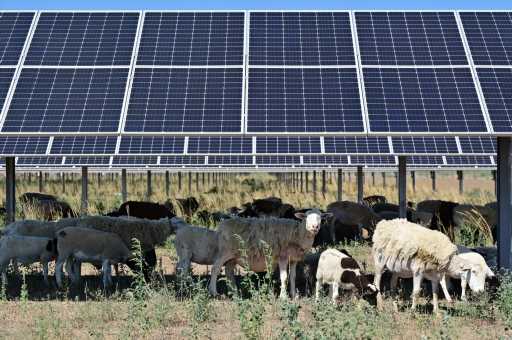Western Colorado county takes second look at large-scale solar project
A proposed solar-energy farm in western Colorado that would provide local power is getting a second chance after an initial rejection and is attracting attention from solar advocates who say it could set a statewide precedent.
In a meeting Tuesday, the Delta County Commissioners will reconsider a plan by Denver-based Guzman Energy for an 80-megawatt solar installation across 472 acres. Proponents say the farm, about two miles east of Delta, could help make Colorado a leader in combining renewable energy and agriculture at a time when there’s a push for more wind and solar energy in the face of climate change.
The land, which had been a ranch, will still be used for agriculture. An area ranching operation will graze 1,000 sheep on the land.
That argument didn’t sway two of the three commissioners, who in March voted against the plan. Opponents, including area residents, were worried about the long-term impacts on agriculture and questioned whether a big solar farm would be compatible with the rural area.
As utilities build or tap into new solar and wind farms, counties that are more accustomed to oil and gas wells than wind turbines and solar panels are figuring out how to respond. Guzman Energy and the Delta-Montrose Electric Association, which will buy some of the electricity to power local homes and businesses, hope the revised proposal wins over the commissioners.
The planning commission voted unanimously in July to recommend that the commissioners approve the project.
“We’re pretty hopeful this time,” said Tim Vigil, the electric cooperative’s chief operating officer. “We feel we’re in a better position to move forward to take about 20 megawatts of the project’s capacity.”
Guzman Energy, a wholesale power provider, says the approximately $80 million project will generate 350 to 400 jobs during construction and $13 million in property taxes over 15 years. It will generate enough electricity to serve about 18,000 households.
“We’ve tried to be really responsive to what the community was interested in and make sure we integrated that agricultural component,” said Robin Lunt, Guzman’s chief strategy officer.
The proposal is an example of agrivoltaics, the use of land for both solar energy generation and agriculture. Some mix livestock grazing and energy generation. Others use the land under the panels for crops to maximize the use of the land.
Parts of rural Colorado have enthusiastically embraced large-scale renewable energy projects. The Western Way, a self-described conservative environmental organization, released a report in 2020 that said renewable energy has brought “thousands of jobs and investment and has supported communities” on Colorado’s Eastern Plains. The report projected that landowners would reap $15.2 million in annual lease payments by 2024 for hosting wind turbines.
Not all sunshine
But the prospect of more solar and wind projects cropping up across Colorado’s rural, open spaces has moved some local governments to call timeout. In January, Morgan County put a six-month moratorium on any projects until it could update its land-use codes.
“The reason we were concerned is because we had nothing in our regulations regarding the big solar and wind farms or even the battery-storage systems,” said Nicole Hay, the county planning department director. “We needed something in the regulations to help protect the residents of Morgan County so these projects weren’t just coming in and doing whatever they wanted because we had no regulations.”
The new codes took effect in July. The head of a solar energy trade group calls Morgan County a success story.
“Honestly, they’ve got the best, most pro-solar policy in the state after having this conversation and really digging in to understand what solar developers needed and what the community needed,” said Mike Kruger, president and CEO of Colorado Solar and Storage Association.
The solar association has met with elected officials and residents in different parts of the state after a handful of counties considered new land-use policies seen the group saw as negative.
“The industry looked around and said if solar is going to happen across the state, we need to get ahead of this and not play whack-a-mole because that takes too dang long,” Kruger said.
Some new land codes for renewable energy include provisions for plans to decommission solar and wind farms and bonds to ensure there’s money to clean up sites.
Kruger said communities are also concerned about drying up agricultural land and the impact on the views.
Conditions of approval
The Delta County planning staff has recommended that Guzman Energy post a $4.4 million to cover reclamation costs when the project, called Garnet Mesa Solar, is shut down. A $100,000 bond would cover any road repairs needed because of construction traffic.
Guzman Energy, which is working with Citra Power to build the solar farm, plans to spend about $1.5 million on landscaping and irrigation. Preliminary plans call for planting 590 trees and 1,440 shrubs.
Guzman worked with local experts to redesign the irrigation plan, which was a sticking point for the two commissioners who voted against the project in March. Area residents voiced concerns about transmission lines and the potential effects of taller power poles on the air space of private planes.
Commissioner Wendell Koontz said it would be inappropriate for him to comment on the project before Tuesday’s meeting. Commissioner Mike Lane didn’t respond to a request for comment.
Don Suppes, chairman of the Delta County board of commissioners and the lone vote for the project in March, said he supports the right of property owners to develop their property. He said the staff did a good job writing the development agreement.
“I felt it was a good, solid project that was going to be good for the valley and good for the power cooperative,” Suppes said. “And quite frankly, the state legislature would cut us off from carbon fuels tomorrow if they had their choice and wouldn’t care how many people they left without power. We need to do everything we can to make sure we’re covered.”
The Colorado General Assembly has passed several laws setting goals for reducing greenhouse-gas emissions and moving from fossil fuels to deal with climate change.
The Delta-Montrose Electric Association said the solar project in Delta County would help realize its goals of using more renewable energy and take advantage of declining wind and solar costs.
“In addition to local hydropower we already have, that project could push us to at least 20% renewable energy from local resources,” said Becky Mashburn, the cooperative’s member relations manager.
Stabilizing rates and developing more local energy sources were some of the reasons Delta-Montrose gave when it paid $62.5 million to end its contract with Tri-State Generation and Transmission Association in 2020.
“I think this is a great project and a model for Delta County to be a leader in agrivoltaics,” said Natasha Léger, executive director of Paonia-based Citizens for a Healthy Community, a conservation group.
Léger said the solar farm received far tougher scrutiny than oil and gas projects have and should be approved because it complies with the county’s land-use codes.
“Utility-scale solar is going to result in basic fixed costs and not be subject to the variable costs of the energy market,” Léger said.
Looking to coexist
SunShare, a Colorado-based developer of community-solar projects, is incorporating agriculture into some of its rural projects in Minnesota and Colorado.
In Colorado, SunShare is working with a rancher who grazes a total of 650 sheep on three community solar gardens on about 100 combined acres in Weld County. Tom Brown, a fourth-generation rancher and Colorado native, said he tended sheep on one of SunShare’s sites last year as a test. “It just really worked out good for both of us.”
Brown Land and Livestock moves the sheep around on each site so they graze just enough to keep the grass down but not too much. If he didn’t use SunShare’s sites, Brown said he would have to find other spots.
David Amster-Olszewski, founder and CEO of SunShare, said he hopes to have more agrivoltaic projects next year.
“From an economic perspective, by combining with solar, you’re solidifying an income stream for farmers and the tax base for communities,” Amster-Olszewski said. “If you can do that at the same time you’re keeping the historic use in those counties, whether it be farming or ranching, you’re not losing anything, you’re gaining.”
Source: Read Full Article




